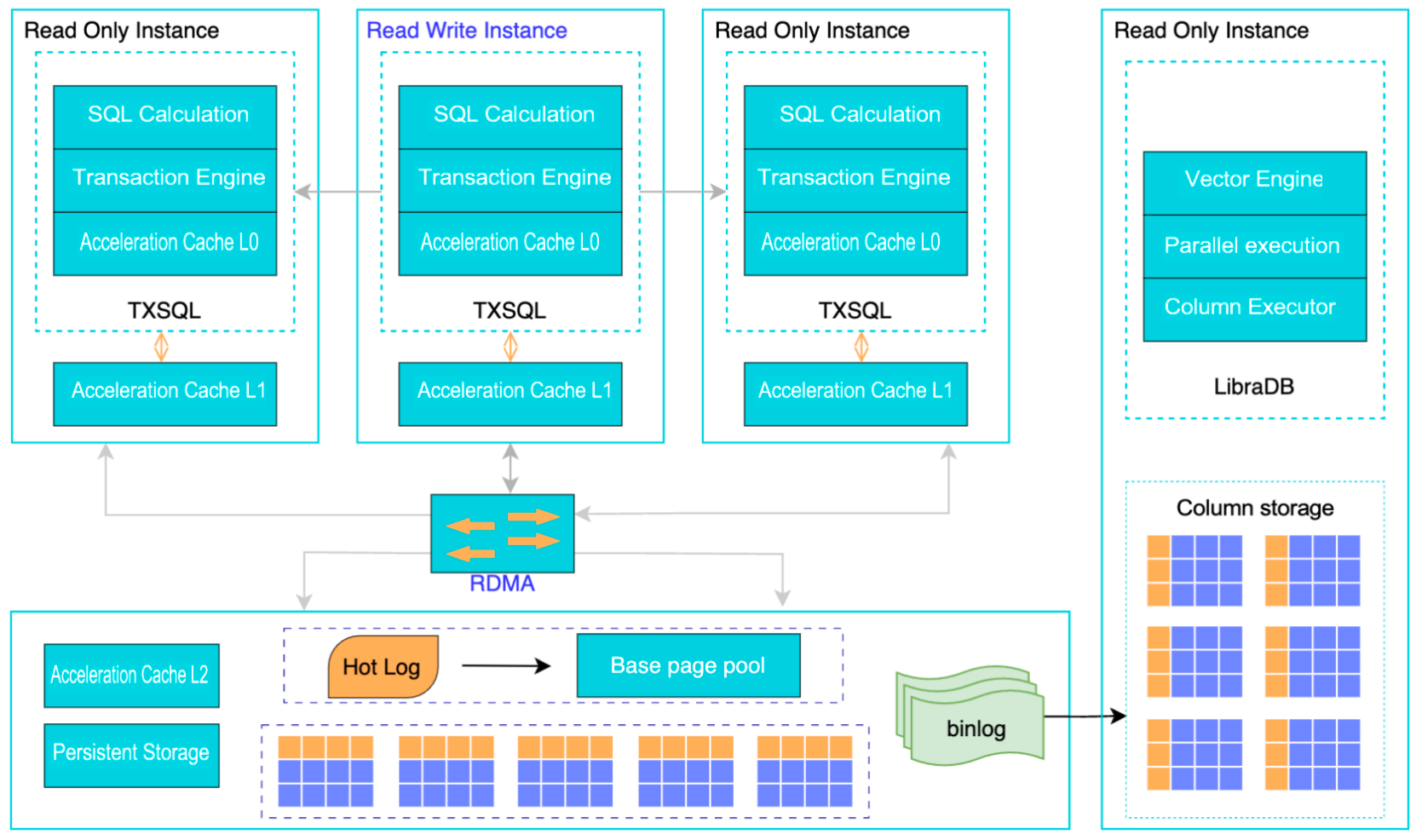Architecture
Last updated: 2024-08-22 10:44:51
TDSQL-C for MySQL is designed based on the Cloud Native concept, integrating the stability, reliability, high performance, and scalability of commercial databases while embracing the simplicity, openness, and efficient iteration of open-source cloud databases. Moreover, through the extended LibraDB engine, TDSQL-C for MySQL can support the needs for high-performance data analysis and real-time complex query processing on a larger scale of data. This document introduces the architecture and features of TDSQL-C for MySQL.
Product architecture diagram

Single-write-multiple-read
A TDSQL-C for MySQL cluster contains one source node and up to 15 read-only nodes. The former processes read and write requests, while the latter processes only read requests.
Computing/Storage separation
TDSQL-C for MySQL separates computing from storage to elastically scale clusters based on business needs in public cloud computing environments. Compute nodes (database engine servers) only store metadata, while remote storage nodes (database storage servers) store data files and redo logs. Only the metadata of redo logs needs to be synced between compute nodes. This greatly reduces the replication delay between the source node and read-only nodes. In addition, when the source node fails, a new node will be quickly started for a smooth switch.
Automatic read/write separation
Automatic read/write separation is a transparent, highly available, and adaptive load balancing feature offered by TDSQL-C for MySQL. After a database proxy address is configured, SQL requests will be automatically forwarded to the nodes in the TDSQL-C for MySQL cluster. This mechanism provides aggregated and high-throughput capabilities to process concurrent SQL requests.
Interconnection through high-speed linkage
TDSQL-C for MySQL supports full-linkage transfer with remote direct memory access (RDMA), where data is transferred from the memory of a computer directly to another computer without intervention from both operating systems required. This further optimizes the system performance at critical paths and minimizes the request delay, so that the I/O performance is no longer a bottleneck. In addition, an RDMA network is also used between stored copies.
Shared distributed storage
Data is shared by multiple compute nodes rather than stored on each compute node. This greatly reduces the storage costs. Based on the newly created distributed block storage and file system, the storage capacity can be smoothly expanded online to sustain petabytes of data without being limited by the storage capacity of a single database server.
Multi-copy strong consistency
Data is stored on the storage nodes of the database in three copies, which ensures a high data reliability. In addition, the strong multi-copy consistency policy is adopted to guarantee the data consistency. Fees are charged based on the data volume in only one copy.
Integration of multiple proprietary engines
TDSQL-C for MySQL supports the proprietary engines TXSQL (based on InnoDB) and LibraDB. The TXSQL engine is specifically optimized and supported for enterprise-level application scenarios, boasting exceptional features such as hotspot update protection, SQL throttling, rapid column modification, parallel queries, database audit, and thread pool. These features significantly enhance the performance and stability of cloud-native databases. The LibraDB engine possesses capabilities for large-scale parallel computing, vectorized processing, columnar data storage, and real-time row-to-column conversion, as well as a cost-based columnar optimizer. These capabilities greatly improve the performance of complex queries on large-scale data, fully meeting the business needs for real-time analysis and processing of online data.
Was this page helpful?
You can also Contact Sales or Submit a Ticket for help.
Yes
No
Feedback

